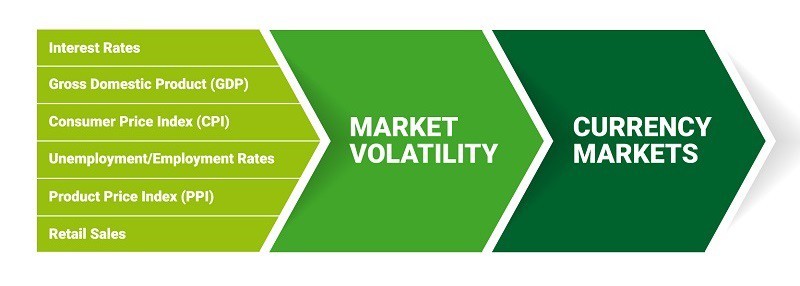So, there are fundamental or, in other words, economic factors, that influence currency exchange rates.
1. Economic indicators
Economic indicators are snippets of economic and financial data released by private and governmental agencies. These statistics help us monitor the market’s drivers and react to their slightest changes. To respond to economic releases in a proper way you need to understand the relationship between statistical reports and the exchange rates of the currencies in question. We would now like to introduce the most influential economic indicators and define their impact on the prices of the currencies.

Output indicators: GDP, industrial production, retail sales. Any increase in the published data tells us that the economy is growing. If the releases are strong, look for the appreciation of the currency.
Sentiment indicators: business and consumer sentiment. This group of indicators serves as the barometer of the mood of consumers or investors. The more they spend/invest, the stronger the national economy and currency.
Labor market indicators: unemployment rate, payrolls, employment/unemployment change, unemployment claims. The higher is employment, the better for the national currency (the opposite with unemployment).
Housing market indicators: building permits/consents/approvals, housing starts, new/existing/pending home sales. If there is a sign of increasing economic activity in the housing market, it means that the national economy is healthy. This causes the exchange rate of nation’s currency to rise.
Inflation: CPI, PPI, WPI, RPI. Higher inflation is negative for the national currency, while lower inflation is positive. In the short-term, however, CPI and other inflation indexes may have an opposite effect on the currency. Significant increases in the inflation gauges may push the central bank to raise its interest rate. This may cause the exchange rate of the currency to rise.
Trade balance: the total value of the nation’s exports minus the total value of its imports; >0 means a surplus, <0 means a deficit. When a country has a trade surplus, demand for its currency from foreign buyers increases, so the national currency appreciates. In contrast, a trade deficit causes the depreciation of the nation’s currency.
Current account balance: the balance between a country and its trading partners, reflecting all payments for goods, services, interest, and dividends; >0 means a surplus, <0 means a deficit. A deficit means that the country is spending more than it is earning and that it is borrowing capital from abroad to reduce the deficit. The impact on the national currency is negative. Surplus, on the contrary, has a positive impact on the currency.
2. The monetary policy of central banks
Interest rates. All major central banks set their key refinancing rate. There are two types of monetary policy: easing (lowering the interest rate if the national economy needs a boost; the impact on the currency is negative) and tightening (raising the interest rate in order to slow down rising inflation rate; the impact on the currency is positive).
Bond purchases. Sometimes central banks recourse to the massive purchases of government bonds aiming to increase the amount of money in circulation; by doing so they try to make credits cheaper and boost economic growth. These unconventional monetary measures lead to the depreciation of the currency. Central bank’s bond purchases that lead to higher money supply are known as quantitative easing (QE).
3. Government’s fiscal health.
Budget balance and debt. If a country is deeply in debt, it is less attractive for foreign investors, because large public debts lead to inflation. In addition, a large debt may prove worrisome to foreigners if they believe the country risks defaulting on its obligations. In this case, demand for the country’s currency will decline and its exchange rate will go down.
4. News flow
- Political, social and other news.
- Economic forecasts from IMF, OECD, World Bank, and other organizations.
- Changes in sovereign credit ratings by Moody’s, Fitch, S&P and other agencies.
Foreign investors tend to seek out politically and economically stable countries. That’s why reoccurring news about political turmoil or unrest draws investments away from the affected country. As a result, its national currency depreciates due to the outflow of foreign investments. Sometimes even politically stable countries experience social disturbances, governmental reshufflings and significant legislative changes. All these events can also influence the currency. Unexpected results of election or referendum can cause great currency volatility (do you remember the effect of Trump’s victory or the consequences of the UK “leave” vote). Political statements of national leaders, public engagements of the central banks’ governors can make the currency’s price fluctuate.
Considerable changes in the exchange rate of the currency can also be caused by the news flow of a different kind. We are talking about economic forecasts from such financial institutions as IMF, OECR, World Bank, or changes in sovereign credit ratings by Moody’s, Fitch, S&P and other agencies.
Finally, some truly unexpected events like earthquakes and other natural disasters. These events are destructive for economies and, consequently, for the exchange rates. However, the relationship is not always simple. For example, back in 2011 Japanese yen actually strengthened after an earthquake in Japan: the reason was that investors perceived the yen as a safe, refuge currency and it rose during the times when the market’s risk appetite plunged.



0 commentaires:
Enregistrer un commentaire